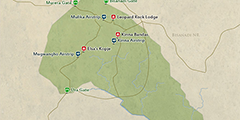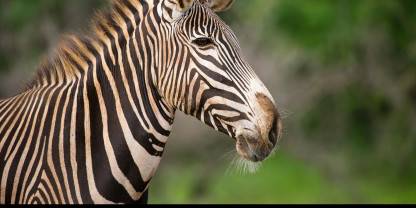If Meru National Park were elsewhere in Kenya, it would be filled with visitors, and yet you may have it all to yourself. It’s a beautiful park and one of Kenya’s little-known gems. All of the Big Five are here, and all three big cats are a possibility. Down in the park’s south, you can even see the grave of Elsa the lioness, star of the movie ‘Born Free’. The park also has a large rhino sanctuary where sightings are likely.

-
Best Time To Go
- June to October (Little to no rainfall)
-
High Season
- December to March and July to October (Not busy)
-
Size
- 870km² / 336mi²
-
Altitude
-
333-763m /1,093-2,503ft
 View Photos
View Photos
 View Photos
+24
Photos
View Photos
+24
Photos
 Open Map
Open Map
Pros & Cons
- Good wildlife viewing with some dry-country specials
- The park is never busy
- Stunning scenery
- Excellent birding
- A handful of great accommodations options
- Animals aren’t very habituated
- Predator sightings are not guaranteed
Wildlife
Meru is home to the Big Five. Elephants migrate through the park and big herds can sometimes be encountered. Big cats are more difficult to spot, but it isn’t rare to have a sighting all to yourself: watch for leopards along the Rojewero River. You’ll see lots of buffalo, waterbuck, Grant’s gazelle and hippo. Northern Kenya specials include the Beisa oryx, the stunning reticulated giraffe (often seen in large family groups) and the gerenuk.
More about Meru's wildlifeScenery
As you drive into the park for the first time, it’s hard not to fall in love with the dramatic scenery: distant hills rise from the horizon with tall doum palms silhouetted against the sky. The Rojewero and Tana Rivers are lined with lush vegetation, and the palms, baobab trees and red soil provide a striking background for the park’s many animals.
Activities
Guided are the main activities in Meru National Park. These are an opportunity to enjoy the wildlife (including birds) and scenery, and to learn about them from an expert guide. The only place where you’re allowed out of your vehicle in the park is at one of the campsites, or at the viewing platforms overlooking the Rojewero River.
Weather & Climate
The levels of rainfall change dramatically over the course of a year. Most of the Dry season (June to October) sees very little rain. This changes in October, when the rainfall edges up in advance of the Wet season (November to May). The opposite is true of temperatures at Meru, whose location near the equator ensures consistent daytime temperatures of around 29°C/84°F.
More about the weather and climateBest Time To Visit
The lack of rain in the Dry season (June to October) makes this the best time to visit Meru. The grass doesn’t grow much, making the wildlife easier to spot, and conditions are generally better for navigating the park’s lovely landscape. In the wetter months, high grass tends to obscure the animals, and elephants depart for drier ground.
More about the best time to visit



